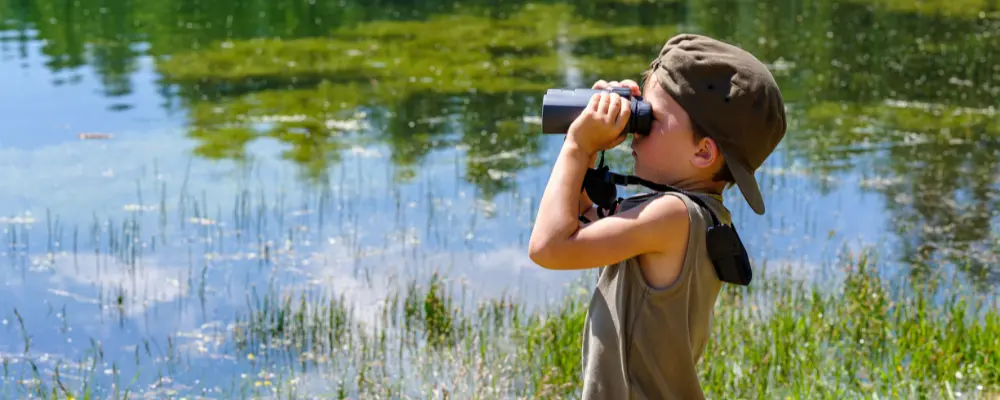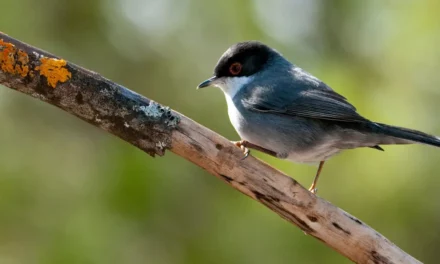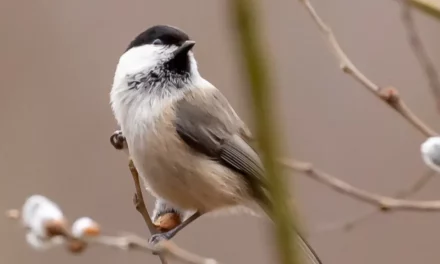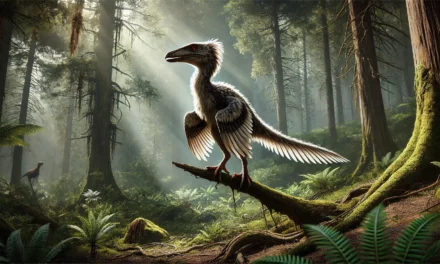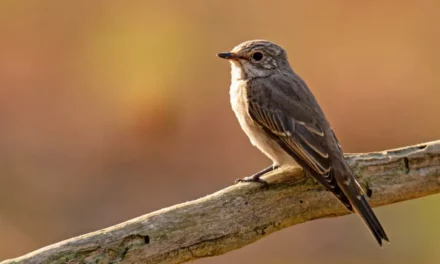How to Choose a Good Ornithology Course? The Complete Guide to Learning Bird Identification
How do you choose a good ornithology course? Methods, criteria, tools: the complete guide to making meaningful progress, even if you're starting from scratch.
In this guide
🧭 Introduction: Why this guide?
In recent years, interest in nature has been steadily growing. Walks in the forest or along rivers are no longer just simple strolls: they become opportunities to observe, understand, and name. And among all the living beings populating our landscapes, birds hold a special place. We hear them before we see them; they're everywhere-both familiar and mysterious.
With this surge of interest, the number of available courses has exploded. Specialized books, educational videos, nature workshops, MOOCs, automatic recognition apps, online courses... It has never been easier to get started.
The offerings are vast, but making deep progress remains challenging.
Many curious learners, even when motivated, give up after just a few weeks:
- The songs start to blend together.
- The silhouettes all look alike.
- Memory doesn't keep up.
- And the initial enthusiasm slowly fades.
This guide was created specifically to help you avoid these pitfalls.
Its goal: to help you make informed choices, avoid dead ends, and find the approach that will suit you best-whether you're a complete beginner or an amateur eager to improve.
In this guide, you will discover:
- What makes a good ornithology course, based on learning science and field experience
- How to identify your real needs, depending on your level, available time, and goals
- What common pitfalls to avoid in online courses and resources
- And most importantly: how to make lasting progress, in just a few minutes a day, without losing motivation or getting lost in the flood of available information.
This guide will accompany you in your reflection, helping you choose a course that truly suits you and will help you progress over the long term.

I. 🌿 Why learn to recognize birds?
1.1 The joy of discovering living beings
Learning to recognize birds isn't just about collecting names or checking boxes on a list. Above all, it's about relearning how to observe.
In our lives, often dominated by screens, constant distractions, and fast-paced routines, birds are all around us-but invisible. We hear them singing without paying attention. We catch glimpses of them in trees but don't know their names. Yet, the moment you start naming them, identifying a song, or noticing a behavior… the landscape transforms.
Recognizing a bird means opening your eyes to something you hadn't truly seen before. You no longer just see "a bird," but a black redstart perched on a gutter, a blue tit hovering mid-air, a nuthatch climbing down a tree trunk headfirst. It's a small shift in how you see, but one that profoundly changes your relationship with the world.
These first identifications leave a lasting impression. They generate a deep emotional impact because they connect a simple observation to clear knowledge. It's no longer vague; it's identified and named. You suddenly feel closer to the living world, more anchored in the real world.
This is often where the motivation to learn begins-not out of a desire for encyclopedic knowledge, but out of a wish to sharpen your observation, to understand what you're seeing, and to be able to share it with others.
1.2 Cognitive and emotional benefits
Learning to recognize birds also trains your mind. Regular observation engages essential skills: concentration, memory, attentional sharpness. You learn to notice details-a beak shape, a tonal nuance in a song, a fleeting behavior-and to connect them to mental anchors built over time. This work of selection, comparison, and memorization stimulates cognitive abilities deeply, sometimes without you even realizing it.
But beyond the cognitive aspect, there's a broader, more tangible effect: you feel good. Bird identification fosters a sense of grounding, a return to reality, a calmer, more attentive presence in the world. Many learners describe a sense of peace, a renewed curiosity, and the joy of being surprised.
It's an activity that combines movement and attention, knowledge and life. It gives every outing, no matter how simple, a new depth. You no longer just pass through a landscape-you inhabit it. You no longer just hear noise-you recognize presence.

II. 🧠 The basics of ornithological learning
2.1 What does it really mean to recognize a bird
Recognizing a bird isn't just about being able to name it from a photo. It's about being able to encounter a species in real conditions-often imperfect ones (changing light, fast movement, partial view)-and use multiple clues to identify it accurately.
It's a composite skill that relies on three main types of clues:
- Visual cues: plumage color, of course, but also general shape, relative size, flight silhouette, or details like a wing bar, crown, or cheek patch.
- Auditory clues: songs and calls, which can be highly distinctive, sometimes more reliable than appearance. Some birds look very similar visually but are perfectly distinguishable by ear.
- Behavioral and contextual clues: typical habitat, posture, flight style, feeding behavior, time of day… Once integrated, all these elements help refine identification.
It's therefore a multisensory activity, where you learn to combine visual, auditory, and behavioral observations. And it's precisely this combination that gradually moves you from uncertainty to clear recognition.
2.2 Why does memory fail us
Many people start learning birds with motivation… but quickly give up, convinced they "have no memory." In reality, it's not a question of capacity-it's a question of method.
📌 First cause: cognitive overload
When discovering a species, you're often flooded with information: plumage, song, habitat, behavior, scientific name, male/female differences… The brain tries to retain everything at once, without prioritization, and barely encodes anything long-term. Result: after a few days, everything gets jumbled.
📌 Second cause: passive learning
Many resources (field guides, videos, apps) merely present the species… but never actively engage memory. You watch, you listen, but you don't test yourself. Yet without retrieval effort, information slips away without anchoring.
📌 Third cause: lack of planned revision
Human memory works through successive recalls. Information seen once is quickly forgotten. Without a structured revision system, each learning session starts almost from scratch, as if nothing had been gained. It's discouraging and inefficient.
Forgetting isn't a personal failure but a logical consequence of poorly designed learning. Conversely, a well-designed system can transform a "bad" memory into one that's efficient, stable, and durable.
2.3 What cognitive science says
If so many learners give up despite their motivation, it's because most courses, even well-meaning ones, aren't aligned with how human memory actually works. Yet for decades, cognitive science has highlighted robust principles for anchoring knowledge long-term.
Among them, three are particularly relevant for learning ornithology: spaced repetition, active recall, and targeted comparison.
🔁 1. Spaced repetition
Human memory is built to forget. This is a normal, even desirable mechanism: it allows us to filter out unnecessary information and retain only what has long-term value.
But for information to be considered "important," the brain needs to encounter it several times. This is the fundamental principle of repetition.
This is where spaced repetition comes in, one of the most powerful tools validated by cognitive science (Ebbinghaus, 1885; Kang, 2016) to strengthen long-term memory.
The principle: we retain better when we review information just before we forget it. If we review too early, we waste time. Too late, and we're back to square one. The solution: space out revisions progressively, based on the level of mastery.
Many studies (notably Kang, 2016) have shown that this method doubles or even triples learning efficiency.
This process creates a personalized learning trajectory, where each piece of knowledge evolves at its own pace. You don't review everything all the time, only what needs to be reviewed, at the right moment.
This is especially crucial in a subject like ornithology, where each species involves multiple parameters to memorize: color, shape, behavior, call, habitat, seasonality...
Without an intelligent revision system, these details fade, get mixed up, or remain too vague to be useful in the field. With spaced repetition, each cue is progressively consolidated, and you avoid the cognitive overload linked to massive or disorganized rereading.

🧠 2. Active recall
Another common learning bias is believing we've "retained" something simply because we've reread or recognized the information. In reality, recognition is not the same as recall.
Research shows that memory is much better anchored when we're forced to remember on our own, without help. This is the principle of active recall.
Practically, this involves exercises where you must retrieve the information yourself, without being helped by multiple-choice options or hints. You read a question, search for the answer from memory, then check. You can also practice in writing or speaking, by reformulating what you've learned.
This type of cognitive effort, though slightly more demanding, strengthens neural consolidation and allows for faster retrieval in the field.
🔍 3. Targeted comparison
Learning each species individually helps build a solid base, but to refine your recognition, targeted comparison can also be an extremely effective lever.
The brain remembers much better when it can contrast two similar elements: it more easily retains what differentiates them than what they are individually.
This is especially useful in ornithology, where many species look alike.
Seeing them side by side, hearing their songs one after the other, observing their differences in silhouette or behavior, helps anchor the right cues more firmly and avoids persistent confusion.
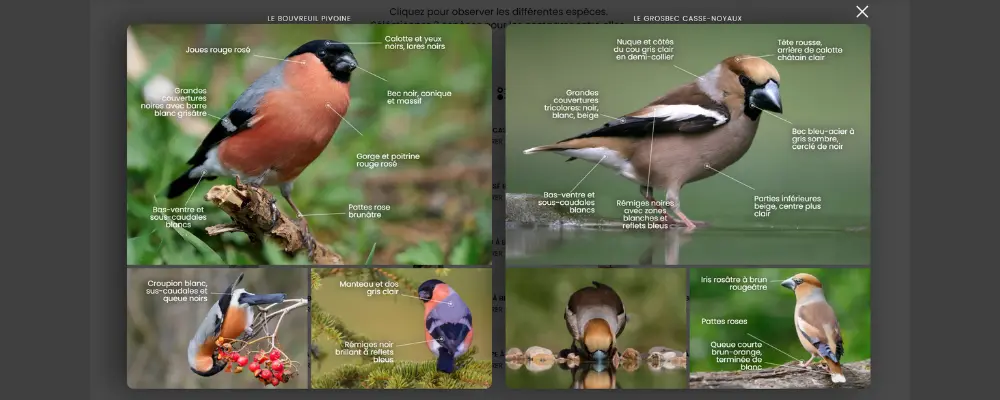
III. 🎓 The types of courses available
3.1 In-person: workshops, clubs, guided outings
Field ornithology has historically been passed down through practice and the company of enthusiasts. Before the digital era, learning to recognize birds often meant accompanying an experienced naturalist in the field, binoculars in hand. Even today, ornithology workshops, organized outings, and local clubs remain highly appreciated learning formats, especially for beginners.
✅ Advantages of in-person learning
The most obvious advantage is direct immersion in the natural environment. Observing birds in their real-world setting, hearing their songs in context, noting their behavior live-all this helps create powerful memory anchors. It's not just about seeing a bird but experiencing it: the place, the moment, the light, the weather… These elements make recognition more vivid, more sensory, and often more lasting.
Another strength of in-person learning is human interaction. Being guided by an experienced person allows you to:
- get targeted explanations,
- ask spontaneous questions,
- be corrected or guided in real time,
Finally, for many people, learning is more motivating in a group: you feel supported, progress together, discover species you might not have encountered alone, and share discoveries. This plays a strong role in engagement and self-confidence.
⚠️ But also limitations to know
Despite its strengths, in-person learning isn't always sufficient to build autonomous, long-term skills.
First, it's occasional: a workshop lasts two days, an outing a few hours. While the enthusiasm is there, the memory anchoring is often fragile. Without structured follow-up afterward, the observed species are quickly forgotten. As we've seen, memory needs repetition over time to consolidate what it captured in the moment.
Next, the pace is collective, rarely tailored to the individual. In a group, some already have a foundation, while others are lost. The guide does their best to satisfy everyone, but each person learns at their own speed. For the most novice or shy participants, this can lead to frustration or disengagement.
There's also a logistical dimension to consider: workshop availability, travel distances, budget, unpredictable weather… Not everyone can follow this type of format regularly.
Finally, few of these outings are pedagogically structured like a true course: they often lack a planned progression, consolidation materials, a revision system, or personalized follow-up.
Workshops and guided outings are excellent for getting started, reconnecting with the field, reigniting motivation, or progressing on a specific point. They let you see birds "for real," in their natural conditions.
However, they are best complemented by more regular, personalized learning to reinforce memorization and structure progress. Today, many people choose to combine in-person experiences with an online course, so they can advance at their own pace between outings and avoid forgetting everything between walks.

3.2 Books, PDFs, paper guides
Another classic format for learning ornithology: specialized books, illustrated nature guides, and printable PDFs or documents. They hold an important place in birding culture-and rightfully so: they provide a wealth of structured information, often of high quality, accessible at any time.
✅ An excellent reference tool
A good bird guide, whether in paper or digital form, allows you to:
- Quickly find information about an observed species (size, diet, behavior...)
- Compare illustrations
- Reread precise data at your own pace: migration, distribution, nesting, etc.
It's also a reassuring format: being able to flip through, annotate, or simply take the time to observe an illustrated plate remains a unique pleasure. Some field guides are even designed to be brought along on walks and allow you to check an identification on the spot.
PDF documents or downloadable materials (created by associations, enthusiasts, or training organizations) are also useful: they often complement online learning or workshops with summary sheets or educational materials.
⚠️ But a format not well suited for beginners
Despite their qualities, books and printed materials pose challenges when you're truly just starting out.
The first is that these documents are designed to be consulted, not learned. You enter them out of need, rarely following a progression. Generally, there's no guided pathway, no memorization system, no structure designed for gradual assimilation. This can create the illusion of acquired knowledge… when in reality, very little information is retained long-term.
Next, these formats assume a capacity for self-direction: where to start? Which species to prioritize? How do you know if you're progressing? Nothing really indicates this. For a beginner, this can quickly become discouraging or confusing, especially when facing dense books covering hundreds of species.
Another challenge: the passivity of learning. Reading, observing-even attentively-isn't enough. Without retrieval effort, without real-life application, without review, memory doesn't consolidate. Cognitive science has clearly shown: passive repetition is ineffective, especially when facing a massive amount of information, as in ornithology.
Finally, even the best guides present sensory limitations. An illustration is static and doesn't always capture a behavior, a song, or a typical posture. Some guides do include QR codes linking to sounds or videos, but these remain secondary and are rarely integrated into a structured learning logic.
Books, PDFs, and guides are excellent complements for structuring your knowledge, reviewing information, or deepening a specific point. They remain indispensable reference tools, even for advanced learners.
But they are rarely sufficient to initiate structured progress or to support a beginner through the successive steps of learning. They benefit from being paired with more interactive, more active formats.
3.3 Mobile apps and videos
Automatic recognition apps (photo or audio) have transformed the way the general public engages with birds in just a few years. Easy to use, available anytime, they let you get the probable name of a seen or heard bird within seconds, simply by capturing a song or an image. This technological promise is appealing: millions now use these tools to identify what they encounter in the field.
✅ An effective entry point, accessible to all
Their main advantage is clear: they make ornithology immediately accessible, without prerequisites or specialized equipment. Just take out your phone, open the app, and let the microphone or camera do the work. Some of them (like Merlin, BirdNET, or Bird ID) even offer probability-ranked suggestions, comparison audio clips, or mini descriptive fact sheets.
They provide a valuable gateway for those hesitant to "get started," who have never learned to identify a species on their own, or who simply want to put a name to a song heard during a walk. They also allow you to quickly check a hypothesis or gain confidence with certain familiar species.
⚠️ But it's not really learning
That said, these apps aren't true learning tools. They identify for you, but don't really help you retain.
By giving you the answer directly, they bypass the mental effort required for memorization. The brain doesn't search, compare, or retrieve. It consumes external information… and forgets it immediately. This is a well-known phenomenon: recognition (outsourced) is not the same as knowledge (acquired).
Worse still: these apps can reinforce confusion. Many species look or sound very similar. Without a structured system, the user poorly retains the differences and risks accepting a response that is, at times, uncertain or incorrect. Recognition performance varies depending on recording conditions, background noise, photo quality, and errors, while inevitable, are rarely explained.
📺 And what about videos?
Educational videos (YouTube, social media) can offer a supplement: discovering a species, listening to a song, observing behavior. Some channels are well-constructed, others very superficial. But the same issue remains: most are designed to be watched, not internalized.
They offer no pathway, no assessment, no revision system. You consume them… and move on.
Recognition apps are assistive tools, not learning tools. They're useful, practical, and motivating, but they don't replace a structured course based on recall effort, repetition, and active comparison.
As for videos, they can spark curiosity, illustrate a specific point, or enrich existing content, but they're not enough on their own to ensure lasting progress.
To truly learn to recognize birds, these tools should be considered complements, not main solutions.
3.4 Online courses: complete overview
With the rise of digital platforms and growing interest in nature, online ornithology courses have multiplied in recent years. But under the label "course," you'll find very different formats, with highly variable levels of support and pedagogical effectiveness. To navigate them, it's essential to distinguish three main categories: naturalist MOOCs, educational YouTube channels, and structured pedagogical courses.
🎓 1. Naturalist MOOCs
Some public organizations, associations, or universities offer free or semi-free online courses, often in the form of MOOCs (Massive Open Online Courses). These cover topics like biodiversity, garden birds, or the evolution of bird behavior. They are usually offered at set dates, with a release schedule, videos, quizzes, and sometimes forums.
✅ Their advantage: appreciated scientific rigor, content validated by experts, and good accessibility.
⚠️ Their limitation: these are often general, not very interactive contents, without real support or individualized progression systems. Most importantly, they don't develop real field recognition skills: they inform more than they train.
📺 2. Educational YouTube channels
YouTube is full of bird videos: guided walks, species profiles, sound clips, observation tips… Some channels stand out for their quality, clear explanations, or field footage.
✅ Their advantage: an accessible, free, engaging format that lets you discover species and broaden your naturalist knowledge.
⚠️ Their limitation: these contents are rarely organized as a progressive learning path. They offer no method, quizzes, or revision plan. You learn by watching… but rarely by retaining. The gap between watching a video and gaining real skill remains hard to bridge.
🧠 3. Structured pedagogical courses
Less common but growing, some platforms offer true pedagogical programs, designed according to cognitive science principles. The goal is no longer just to inform or inspire, but to help learners acquire a concrete and lasting skill.
These courses are generally:
- modular and progressive (concepts introduced step by step),
- interactive (quizzes, exercises…),
- supported by a revision system,
- oriented toward field application (listening, visual recognition, behavior…).
Some programs go even further with original tools: song or species comparators, collectible cards, personalized tracking…
✅ Their advantage: a complete and effective approach that respects how memory works and matches real-world conditions.
⚠️ Their limitation: they are generally paid and require regular commitment, even if brief. But they're also the only ones offering true skill development over time.
Not all online courses are equal, and it's not just a matter of content but of structure and method. A good course doesn't drown you in species: it teaches you how to learn, how to retain, how to progress.
That's where pedagogy makes all the difference.

IV. ✅ How to recognize a good online course?
4.1 Progressive, structured, modular content
One of the first criteria for a good online course is the quality of its structure. An effective course doesn't just pile up species sheets or explanatory videos: it offers a clear path, graduated steps, and content adapted to the learner.
🎯 A progression designed to support learning
Learning to recognize birds involves juggling many data points: sounds, shapes, behaviors, habitats… Without a guiding thread, it's easy to get lost. A good course should therefore offer:
- a module-based pathway,
- explicit objectives at each level,
- a logical organization: starting with the most common species, familiar habitats, the most distinctive songs, etc.
This allows learners to feel their progress: they're not just "watching content," they're building a skill.
🧩 Adaptability to the learner's actual level
Everyone comes in with a different background: some already have a few basics, others are starting from scratch. A good course should be able to:
- let you advance faster where you're comfortable,
- offer targeted reviews on topics not yet mastered,
- provide a flexible pace, compatible with daily life constraints.
This implies a certain modularity: being able to pick up where you left off, navigate freely through the content, revisit a species or song, adjust session lengths…
It's this flexibility that allows you to stay consistent over time. Because birding skills aren't learned in a week: they require regularity, but also kindness toward your own pace.
In short, good educational content:
- is organized in coherent steps,
- and gives each person the freedom to progress at their own rhythm, without ever feeling lost.
4.2 Multimodality: audio, image, video, text
Recognizing a bird doesn't come just from reading a fact sheet. It's a sensory and contextual skill that engages vision, hearing, memory, and attention. A good online course should therefore offer varied formats to meet this reality.
🎧 Sound: essential for songs and calls
Many species are primarily distinguished by their song or call. For some (nightingale, chiffchaff, song thrush...), sound identification is even more reliable than visual identification, especially in wooded or dense environments.
A good course should therefore allow you to:
- listen to clear, well-isolated sound clips,
- rewind, slow down, compare,
- actively train to recognize a species without seeing it.
This is where a song comparator, like the one integrated into some Mnemolia courses, becomes particularly effective: it lets you hear two similar species side by side to sharpen your ear and better anchor the differences.
📸 Image: to observe details
Plumage, silhouette, colors, patterns-all elements that only a still image lets you examine in detail. Good courses rely on:
- high-quality, zoomable photos,
- annotated illustrations that highlight key points,
- morphological comparators to distinguish very similar species.
🎥 Video: capturing movement and behavior
Overall posture, flight style, feeding or movement patterns-these behavioral cues can't be fully captured by a photo. Videos let you:
- see a bird in real-life context,
- observe its typical behaviors (tail flicking, jerky flight...),
- better memorize the entire scene.
This type of content strengthens immersive learning by closely mimicking the field experience.
📄 Text: synthesis, explanation, cognitive cues
Finally, a well-written, concise text without unnecessary jargon remains essential for:
- clarifying concepts,
- introducing mnemonic cues,
- providing species context (habitat, season, possible lookalikes...).
Text alone isn't enough, but it structures what the media shows. It also lets each learner go at their own pace, reread, and make connections.
An effective course doesn't stick to a single format. It leverages the complementarity of media to offer richer, more vivid, and more solid learning.
🧠 Memory loves media associations for faster, more reliable, and more lasting recognition.

4.3 Regular practice, self-assessment, review system
A common mistake in learning birds, as in many other fields, is approaching the content as material to consume: we read, watch, listen… and move on. But recognizing a bird is a skill. And a skill is only built through practice, trial, error, repetition.
🔁 The importance of regularity
Trying to learn thirty species all at once is not only ineffective, it's discouraging. On the other hand, dedicating a few minutes a day to targeted practice, even very short, produces concrete and lasting results.
Effective courses therefore offer an adapted learning rhythm, with:
- a limited number of new concepts per session,
- easy resumption of the course where you left off,
- encouragement to practice little by little, but every day.
This logic allows you to move from intention ("I'd like to learn birds") to action ("I'm actually making progress, a bit every day").
🧠 Self-assessment: the engine of memorization
Another key lies in how you interact with what you learn. Simply rereading a species sheet three times won't make you remember it. You'll retain it by trying to retrieve it without help.
Courses based on cognitive science favor what's called active recall: you're asked a question, you must mentally formulate the answer before checking it. This is what, for example, front-and-back card-style quizzes do: they force the brain to search for the information instead of passively recognizing it.
This mechanism transforms vague data into usable knowledge. And above all, it gives learners immediate feedback on their progress, errors, and areas of uncertainty.
📅 An intelligent review system
Learning isn't just about discovering: it's also about reviewing at the right time. Without a review system, we forget. It's inevitable. A serious course must therefore include an **automated review plan**.
Example:
- each concept is reviewed a few days after first learning it,
- the better it's mastered, the longer the interval between reviews,
- the more uncertain it is, the sooner it comes back.
This system allows you to consolidate memory without overload and progressively anchor knowledge over time. This is what Mnemolia courses, for example, offer: each day, the user receives a personalized selection of cards to review, calculated by an adaptive algorithm.
A good course doesn't flood you with species. It gets you to practice, reflect, correct, and try again. It supports you over the long term, emphasizing learning through action, adjustment, and reinforcement.

4.4 Interaction, game, gamification
Learning seriously doesn't mean learning in an austere way. On the contrary: the most effective courses are often those that manage to keep learners engaged by making them active participants in their own journey, even introducing elements of fun and play.
This is what we now call, in the field of pedagogy, gamification: integrating playful, interactive, or symbolically rewarding elements into a learning path, without sacrificing rigor or depth.
This approach helps combat passivity, the main cause of drop-off or forgetting in online courses. It also stimulates motivation by creating a constant sense of progress.
🎮 Game as a motivational lever
Integrating game mechanics doesn't mean infantilizing learning. It means recognizing that motivation also comes from the pleasure of seeing your efforts rewarded, tackling challenges, and reaching milestones.
A great example is the collectible card system integrated into courses like Ornitho Mnemolia, Guide Europe.
For each mastered species, the user unlocks a virtual illustrated card (a bit like Pokémon cards), featuring key data (size, weight, habitat, conservation status, etc.). These cards evolve over time: the more you review, the higher the card level goes (up to 5), marking your real mastery of the species.
This system turns learning into a personal quest:
- each card becomes the reflection of acquired knowledge,
- each review session can lead to a reward,
- the collection becomes a living dashboard of your progress.
🧠 It's not just cosmetic
Well-designed gamification enhances memorization. It creates emotional connections, fosters investment, and provides immediate feedback. It anchors knowledge not just in rational memory but also in emotional and visual memory.
It makes learning more embodied, more engaging, more durable. And most importantly, it lets you keep learning without forcing yourself, because you want to go further.
In short, a good course never forgets that learning is a human process-it must remain stimulating, rewarding, and alive. Interaction, play, and visible progress are all tools that support motivation and, therefore, success.
Collectible cards in Ornitho Mnemolia - Guide Europe
V. 🛠️ Features that make the difference
5.1 Song comparator: learning to distinguish
When starting out in ornithology, one of the main sources of confusion comes from bird songs that sound alike. Some sounds seem similar, the differences are subtle, and it becomes hard to know what you heard. Yet, sound recognition is a central axis of learning, especially since many species are easier to hear than to see.
The human brain is very good at comparing-but only when it can access two elements side by side. This is where a still too rare feature in traditional courses comes in: the song comparator.

🎧 Learning to hear the differences
A song comparator lets you:
- select two species at once,
- listen to their songs or calls one after the other or in alternation,
- visualize the differences in rhythm, tone, sound structure,
- better memorize what distinguishes them, not just what defines them.
Let's take a common example:
Blackbird vs. European starling
To a beginner's ear, these two species can sound similar:
- both have melodious songs,
- both are common in urban or suburban areas,
- their songs contain varied, unpredictable elements.
But careful listening reveals clear differences:
- the blackbird has a slow, fluty, richly modulated song,
- the starling has a faster, choppier song, often with imitations or metallic notes.
By listening to them side by side in a comparator, these differences suddenly become obvious. And most importantly, they stick better: the brain hasn't just recorded two sounds; it has learned to actively discriminate.

🧠 Why comparison works so well
Cognitive science shows that memory learns best through contrast. When you isolate a species, it's easy to forget what it "is." But when you contrast it with another, you also remember what it is not.
This is a natural brain mechanism: we more easily retain striking differences between two elements than absolute characteristics. A comparator leverages this bias to support recognition.
In summary, a song comparator is particularly useful for:
- distinguishing similar or often-confused species,
- actively training your ear,
- gaining confidence in the field, even without visuals.
It's a seemingly simple feature, but pedagogically powerful and highly effective for making progress.
5.2 Morphological comparator: refining visual recognition
In ornithology, some confusions are almost inevitable for beginners. Two species may be about the same size, have similar plumage, similar behaviors… and it becomes very difficult to know what you actually saw.
This is where a morphological comparator makes perfect sense. It allows you to put two species side by side on the same interface and compare their visual characteristics point by point.

🖼️ Example: Black-crested tit vs. Marsh tit
At first glance, these two small tits can cause confusion. They both have:
- a dark cap on the head,
- similar size,
- overall discreet plumage.
But placed side by side, the differences stand out:
- the black-crested tit has a light spot on the nape, a large bib, and slightly more contrasting plumage.
- the marsh tit has a more extensive black cap, no white patch, a small bib, and more uniform beige plumage.
A good morphological comparator goes beyond just two side-by-side images. It offers:
- photos taken from the same angle, under comparable conditions,
- clear annotations highlighting key points (beak shape, colors, wing bars...),
- sometimes views in flight, feeding, or singing posture to enrich the analysis.

🔍 Another example: Blackcap vs. Sardinian warbler
Another frequently confusing pair:
- both have a black cap in males,
- discreet gray plumage,
- and sometimes share similar habitats.
But:
- the Sardinian warbler has a well-defined cap, a red eye ring, and a more compact silhouette,
- the blackcap has a cap that blends more into the plumage, a dark eye, and a more slender look.
Again, seeing them side by side creates a clear visual anchor, much more effective than consulting two separate profiles.

🧠 Why it works
Our visual memory works through relationships. It's not so much the "correct" image we remember, but the difference between two similar images. Learning to recognize a species is often about learning not to confuse it with another.
A well-designed comparator helps refine observation, increases attention to detail, and creates strong visual anchors.
🎯 In summary
In summary, a morphological comparator is a valuable tool to overcome classic confusions. It allows you to:
- memorize faster what distinguishes two species,
- correct frequent mistakes,
- reinforce confidence in your visual observations.
Where two separate profiles might increase confusion, a side-by-side comparison immediately clarifies things.
Here's the complete write-up of section 5.4, The intelligent review system, aligned with the previous sections and with solid pedagogical depth:
5.3 The intelligent review system
When learning to recognize birds, the real challenge isn't discovering the information, but retaining it. And more importantly, retaining it long enough to be able to use it in the field, sometimes weeks after learning it.
This is where an essential, yet still too rare, feature comes in: an intelligent review system, based notably on the principles of spaced repetition (see section 2.3).
🧠 A review system that follows the brain's rhythm
Human memory works in cycles. Information seen only once is quickly forgotten. But if it's reviewed at the right moment-just before being forgotten-it becomes increasingly anchored.
An intelligent review system, like the one integrated into the Mnemolia platform, follows this principle: it automatically plans reminders based on your performance on each item.
- If you answered well: the interval before the next review lengthens.
- If you hesitated or forgot: the review comes back sooner.
- If you make multiple mistakes: the item is reinforced more intensively until it stabilizes.
This creates a personalized progression, fully aligned with your actual memory patterns.
📅 What does this actually change?
Each day, the user receives a targeted selection of cards to review. There's no need to figure out what to revise-the system does it for you. This allows you to:
- Save time (you only review what's necessary),
- Reduce mental load (no need to organize sessions yourself),
- Have clear visibility on your progress (updated, mastered, or overdue cards).
The result: learning becomes smooth, durable, and far less frustrating. You move forward without having to "start over from the beginning," and you maintain what you've learned over the long term.

🧠 A system based on concrete data
Some systems, like the MN-4 algorithm designed and used by Mnemolia, go even further: they take into account response time, past mistakes, and the collective experience of other users to adjust review intervals. This type of approach enables very fine personalization, without the learner needing to understand the technical details.
This isn't just a gimmicky algorithm-it's a concrete modeling of how human memory works, turned into a pedagogical tool.
A good review system is invisible but essential. It's what transforms a one-time course into lasting learning.
Without scheduled review, we forget.
With it, we retain-without unnecessary effort, and for the long term.
VI. 🧩 Steps to build your own learning path
6.1 Getting started: don't aim for exhaustiveness
The most common mistake among people starting bird learning is trying to learn everything at once. You open a guide or an app, see hundreds of species, and think: "I have to know them all." The result: you get exhausted, overwhelmed, and eventually give up. It's perfectly understandable-but avoidable.
Ornithological learning is not encyclopedic. It's not a race to amass raw knowledge; it's a progressive construction of reference points. And like any construction, it starts with the basics.
🎯 Focus on the most common species
In a garden, park, hedge, or forest walk, about twenty species appear very often. These are the ones you should learn first:
- tits (blue, great, coal, marsh...),
- robins, blackbirds, sparrows, starlings, chaffinches,
- pigeons, doves, crows,
- a few warblers or chiffchaffs depending on the season.
These species have a huge advantage: you'll encounter them often. So you'll see them again, hear them again, naturally reinforcing your learning. Each encounter becomes a review session.
This is exactly what a well-structured course sets up: starting with species that are common, easy to observe and remember, before gradually increasing the complexity.
🧭 Move by interest, not by obligation
It's unnecessary (and counterproductive) to force yourself to learn a species you're not drawn to. Emotion plays a central role in memory: we remember better what touches us, what sparked our curiosity, what we wanted to name.
If you were struck by the song of an unknown bird heard at dawn… start there. If a species seen in your garden intrigues you… begin with it. Nothing forces you to follow a purely taxonomic or alphabetical logic.
Moving by interest means building a personal mental map, shaped by encounters and moments of realization. And this map is far stronger than a memorized table.
🎯 In summary
In summary: start small, stay close to what you see, follow your curiosity-these are the best ingredients for anchoring yourself in learning without getting discouraged.
6.2 Test your knowledge and make progress
Learning to recognize birds isn't just about reading species profiles or listening to songs on repeat. For learning to be real-meaning usable in the field-you need to go beyond simple exposure to information. You need to practice retrieving what you've learned, distinguish it from similar items, and correct yourself when you make mistakes.
This is where quizzes, useful mistakes, and review cycles come into play.
🧠 Quizzes: activating memory, not passive recognition
A good birding quiz isn't there to "test" you in the school sense. It's designed to strengthen memory through recall effort. The goal is for the user to:
- search for the answer before seeing it,
- mentally engage in making a choice,
- self-evaluate whether they truly know the species.
This "active recall" mechanism is far more effective than simply watching content. It creates a clear signal in the brain: "this information is useful; I need to remember it".
In well-designed courses, quizzes aren't a separate module but are integrated from the discovery phase to immediately turn exposure into memorization.
❌ The value of mistakes
We sometimes fear making mistakes. Yet cognitive science shows that mistakes are a condition for learning, as long as they're followed by immediate feedback.
When you mistake a species, silhouette, or song, you heighten your vigilance for the next time. What was once confused becomes clearer. This is called a constructive error.
Provided you have:
- a clear explanation right after (correction, correct image or sound…),
- the possibility to review the item later (via spaced repetition).
🔁 Review cycles: anchoring over time
This is where the complete learning cycle takes full meaning:
- Discovery of a species (structured multimedia content),
- Testing (quiz or self-assessment),
- Planned review (based on your errors and successes).
This trio allows you to anchor knowledge over time. An effective course places this cycle at the heart of its pedagogy, without requiring the learner to manage everything themselves.
Testing your knowledge isn't a "bonus" in a learning path. It's the engine that turns exposure into real knowledge. A quality course doesn't just transmit-it gets you to act, reflect, correct, consolidate.

VII. 🧭 How to choose THE course that's right for you
7.1 10 simple criteria to evaluate a birding course
With the proliferation of offers, online courses, workshops, YouTube channels, MOOCs, apps… it's often hard to know what to trust. Yet, a few simple criteria let you quickly identify whether a course is serious, structured, and truly designed to help you improve.
Here are 10 points to check, whether you're a beginner or already familiar:
✅ 1. A clear progression
The course doesn't just stack content; it offers a structured path, step by step.
✅ 2. Concrete objectives
It's clearly stated what you'll be able to do at the end (e.g., recognize 40 species, differentiate songs, etc.).
✅ 3. Multimodal content
Sounds, images, videos, texts: the course uses multiple sensory channels to reinforce memory.
✅ 4. Regular quizzes or tests
The learner is actively engaged through exercises, questions, comparators, recognition games...
✅ 5. A planned review system
The course ideally integrates spaced repetition: you don't choose "what to review"-it's automated.
✅ 6. Feedback on your mistakes
Every mistake gives you access to a clear explanation, not just a "correct answer."
✅ 7. Time-based support
There's tracking, a progression logic, a dashboard, or at least some kind of regular checkpoint.
✅ 8. Intelligently selected species
You're not given 200 species all at once, but a carefully curated panel: frequent + useful + progressive.
✅ 9. Real-life compatibility
Sessions are short, flexible, accessible, including on smartphones. No need to sit at a computer for two hours.
✅ 10. A true pedagogical logic
You can tell that the format and tools were designed for learning, not just to "look nice."
These 10 criteria let you quickly sort through offers without needing to be an education or ornithology expert. If a course checks most of these boxes, you're probably in good hands.
7.2 Comparative table (YouTube, MOOC, Mnemolia)
Not all learning formats have the same goals or resources. Some are perfect for discovery, others for deepening knowledge, and a few truly allow you to build lasting skills.
Here's a summary comparison table of three common formats:
| Criterion | YouTube | Naturalist MOOC | Mnemolia Course |
|---|---|---|---|
| Accessibility | Very easy, 100% free | Free or very affordable | Immediate access, free module 1 |
| Pedagogical structure | None or very limited | Linear, rigid path | Modular and progressive path |
| Personalized pace | No | No | Yes, free pace and adaptive review |
| Multimodality (sounds, videos, images) | Varies by video | Fairly good | Very complete (sounds + videos + cards) |
| Active effort / Quizzes | Rare | Some multiple-choice quizzes | Active recall + varied quizzes |
| Planned review (spaced repetition) | No | No | Yes, with intelligent algorithm |
| Progress tracking | None | General or collective | Personal tracking (progress, mastery) |
| Interactivity | Low | Medium | High (comparators, cards, games) |
| Ornithology/field specificity | Varies | Generally more theoretical | Specific, focused on real-world observation |
| Required time commitment | None | Time-limited | Flexible, at your own pace |
🎯 Key takeaways
- YouTube is great for sparking curiosity, discovering species, or listening to a few songs. But the lack of structure and interaction severely limits real learning.
- MOOCs are useful for gaining general knowledge in a university or association setting. But they are often passive and theoretical, with little practical training.
- A structured course like Mnemolia integrates the most effective pedagogical principles (spaced repetition, active recall, multimodality…) to enable real skill development at your own pace.
Each format has its value. But to learn to recognize birds reliably and durably, a course designed for that… makes all the difference.
VIII. ✨ What you can do right now
Reading a guide is good. But it's by taking action that learning truly begins. There's no need to reorganize your entire life or launch into an ambitious plan: often, simply setting a few small milestones is enough to spark momentum.
Here are three concrete actions you can take today or this week to start making progress.
1. 🧭 Identify your learner profile
Take a moment to reflect on your starting point:
- Do you already have visual or auditory reference points?
- Do you prefer learning alone, online, or in a group?
- Do you need a structured framework, or are you more autonomous?
- Are you more drawn to sounds? Images? Fieldwork?
This will help you choose a suitable format and, most importantly, move forward using your strengths, not fighting against them.
2. 🐦 Choose 1 to 3 species to learn this week
No need to cover everything. On the contrary, start small, focused, local:
- Pick a species you often encounter.
- Or one that has intrigued you for a long time.
- Or one you recently heard but didn't recognize.
Start with 1 to 3 species maximum this week. The goal isn't to "know everything" but to not forget these ones.
3. 🎓 Test a free module, compare, decide
The best way to choose a course is… to try it. Most serious programs offer free access to an introductory module.
It's an opportunity to:
see if the teaching style suits you,
test the review system,
compare it with other formats,
and most importantly, check if you actually remember what you learn.
The introductory module of the Ornitho Mnemolia course is free and commitment-free. It starts with the blue tit, a common but often misunderstood species. Discover the free module.
No need to plan everything. Just:
- assess where you are,
- choose a simple starting point,
- and test a method designed to help you progress.
Learning starts with a simple decision: to take the first step, today.
IX. 📚 Resources and references
For those who want to dig deeper, here's a selection of useful references, mixing ornithological works, cognitive science research, and educational resources on effective learning methods.
🧠 Scientific studies on memory
- Ebbinghaus, H. (1885). Über das Gedächtnis. First modeling of the forgetting curve.
- Kang, S.H.K. (2016). Spaced Repetition Promotes Efficient and Effective Learning: Policy Implications for Instruction. Policy Insights from the Behavioral and Brain Sciences.
- Roediger, H.L. & Butler, A.C. (2011). The critical role of retrieval practice in long-term retention. Trends in Cognitive Sciences.
- Cepeda, N.J. et al. (2006). Distributed practice in verbal recall tasks: A review and quantitative synthesis. Psychological Bulletin.
🐦 Recommended French ornithological guides
- Le Guide Ornitho, M. Svensson, L. Mullarney, D. Zetterström (Delachaux et Niestlé)
➝ European reference for visual identification
🎓 Other platforms or educational content
- Merlin Bird ID
➝ Audio recognition app with a global database - MOOC Ornitho, LPO
➝ Free online course, accessible and well explained - oiseaux.net
➝ Species profiles, network of naturalist contributors
🔄 Articles on spaced repetition and active recall
- SuperMemo Guru
➝ Popularized articles by the creator of the first SM-2 algorithm - Mnemolia, MN-4 algorithm
➝ Presentation of the spaced repetition algorithm used in the platform
X. 🙌 Conclusion
Learning to recognize birds is neither reserved for specialists nor out of reach for beginners. It's not about having a gift or "natural" memory: it's a skill, and like any skill, it's acquired with the right framework, the right pace, and the right tools.
This guide has shown: what makes the difference isn't the amount of content, but how that content helps you progress.
When you move step by step, review smartly, observe, test yourself, and see your knowledge stick… motivation follows naturally. You don't force yourself to learn: you want to keep going.
There are many courses out there, each with its strengths and limits.
Among them, Mnemolia offers an approach designed to turn learning into a clear, engaging, and lasting journey:
- by respecting how our memory works,
- by making learning active and progressive,
- by integrating motivating tools (comparators, cards, tracking...),
- and by letting you move at your own pace, without pressure.
The most important thing? Start. One species, one song, one reference point. And see what it unlocks.
Because learning to recognize birds is, above all, relearning how to look and listen-and anyone can do that.
-
